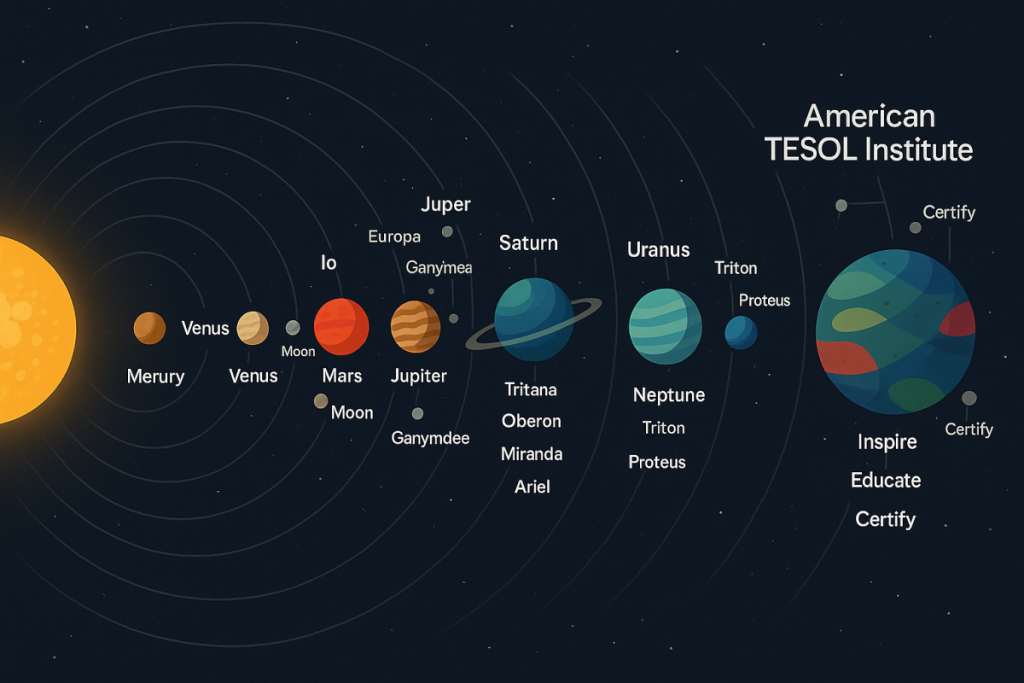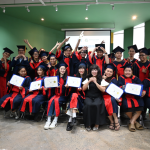As TESOL teachers, we constantly seek innovative ways to engage our students, bridge cultural divides, and enrich their understanding of the world – and the English language. This article proposes an unconventional yet captivating avenue for exploration: the planets. Beyond their astronomical significance, celestial bodies have long served as powerful archetypes in human culture, offering a rich tapestry for discussion, critical thinking, and linguistic development. While maintaining a skeptical, evidence-based approach to astrology, we can still harness the universal appeal of the cosmos to spark curiosity and facilitate meaningful learning.
Planetary Archetypes: Cosmic Personalities and Cultural Icons
An archetype is a timeless “blueprint” in our collective psyche—a recurring symbol or role (Hero, Mentor, Trickster) that surfaces in myths, books, and films worldwide. Like Mars always signaling conflict in cultural lore, an archetype delivers the same core meaning each time it reappears, giving us a ready-made lens for understanding human behavior and stories.
Throughout history, diverse civilizations have imbued the planets with distinct personalities, reflecting their perceived qualities and influence. These “planetary archetypes” offer a fascinating lens through which to examine human traits, cultural values, and even the rise of certain “cults of personality.”
- The Sun (Self/Ego): Not a planet, but the central star of our solar system, the Sun universally represents the self, ego, vitality, and conscious awareness. In many cultures, it symbolizes leadership, royalty, and the source of life. Think of figures who embody radiant self-confidence and inspire others, much like the sun nurtures all life around it.
- Mercury (Communication/Intellect): Swift and elusive, Mercury is the messenger. It embodies communication, intellect, logic, and adaptability. Individuals strong in Mercury’s influence might be quick-witted, articulate, and skilled in various forms of expression. We see its archetype in journalists, writers, and anyone who thrives on the exchange of ideas.
- Venus (Love/Beauty/Harmony): The goddess of love and beauty, Venus symbolizes affection, aesthetics, harmony, and relationships. It represents what we value, what brings us pleasure, and how we connect with others. Artists, peacemakers, and those who prioritize beauty and connection often align with Venusian qualities.
- Mars (Action/Energy/Conflict): The red planet, Mars, is associated with energy, action, assertion, and even aggression. It embodies courage, drive, and the will to conquer. Athletes, soldiers, and individuals with a strong competitive spirit resonate with the Mars archetype.
- Jupiter (Expansion/Wisdom/Optimism): The largest planet, Jupiter, represents expansion, growth, wisdom, optimism, and good fortune. It’s associated with philosophy, higher learning, and a benevolent outlook on life. Teachers, mentors, and those who inspire growth and generosity often embody Jupiterian traits.
- Saturn (Discipline/Structure/Limitations): Saturn, with its rings, signifies structure, discipline, responsibility, and limitations. It represents lessons learned through hard work and the establishment of order. Architects, judges, and individuals who value tradition and long-term planning often reflect Saturnine qualities.
- Uranus (Innovation/Rebellion/Change): The eccentric Uranus embodies innovation, rebellion, sudden change, and individuality. It challenges norms and pushes boundaries. Scientists, revolutionaries, and those who march to the beat of their own drum often align with Uranian energy.
- Neptune (Intuition/Dreams/Illusion): Mysterious Neptune represents intuition, dreams, spirituality, and sometimes illusion or escapism. It blurs boundaries and encourages empathy and artistic expression. Artists, spiritual leaders, and those with a strong imaginative life often embody Neptunian qualities.
- Pluto (Transformation/Power/Regeneration): Though reclassified as a dwarf planet, Pluto’s archetypal power remains significant. It represents transformation, power dynamics, regeneration, and the uncovering of hidden truths. Psychologists, detectives, and those who navigate profound change often resonate with Plutonian themes.
| Planet | Mythic Archetype | Modern-day ESL Angle | Anchor Moons (“Sub-Personalities”) |
|---|---|---|---|
| Mercury | The Trickster-Messenger (speed, wit, trade) | Role-plays on negotiation & fast-paced debate | No major moons – reinforces Mercury’s self-reliance |
| Venus | The Lover & Aesthetic (values, beauty) | Descriptive-language units; comparative adjectives | Moon-less Venus mirrors inward focus on personal taste |
| Earth | The Nurturer-Caretaker | Global-issues projects; conditional futures | Luna – tides – emotional cycles; perfect anchor for modal verbs of possibility |
| Mars | The Warrior (drive, conflict) | Persuasive writing & conflict-resolution tasks | Phobos & Deimos – “fear” & “panic”; good for antonyms/synonyms |
| Jupiter | The King-Expander (growth, justice) | Debates on ethics, law, and scale | Io (volcanic creativity), Europa (hidden potential), Ganymede (largest = ambition), Callisto (outer limits) |
| Saturn | The Sage-Gatekeeper (limits, time) | Classroom routines, SMART goals | Titan (dream-big) vs. Enceladus (small but salty surprises) |
| Uranus | The Rebel-Innovator (disruption) | Technology & futurism projects | Moons named for Shakespearean spirits—great for literature links |
| Neptune | The Mystic-Dreamer (intuition, oceans) | Story-telling, metaphor, poetry | Triton (retrograde orbit) = thinking against the current |
| Pluto (dwarf) | The Shadow-Transformer | Advanced discourse on identity & change | Charon – constant tidal lock – dialogue on partnership |
Moons: The Personality Anchors
Just as planets orbit the Sun, influencing various facets of life, moons often orbit planets, acting as “personality anchors” within their archetypal domain. While not always directly linked to human personality in the same way as planetary archetypes, the concept of a moon as a satellite can be a useful analogy for understanding the grounding or nuanced aspects of a larger archetypal influence. For example, Earth’s Moon, intimately tied to our planet, often symbolizes emotions, instincts, and the subconscious – anchoring the conscious ego (Sun) to our inner world. We can discuss how even within a dominant “planetary personality,” there are smaller, orbiting “moons” that represent specific, anchoring traits or tendencies.
Astrology: A Skeptical Look at the Stars
It’s crucial to approach the topic of astrology with a healthy dose of skepticism in the classroom. Astrology, an ancient practice, purports to explain and predict aspects of a person’s personality and life events based on the positions of celestial bodies at the time of their birth.
Scientific Scrutiny: From a scientific perspective, there is no empirical evidence to support the claims of astrology. Numerous studies have attempted to find correlations between astrological predictions and actual life events or personality traits, consistently yielding null results. The gravitational pull of planets at the time of birth is infinitesimally small compared to other forces, and there’s no known physical mechanism through which celestial positions could influence human destiny or personality. The concept of “energy” or “vibrations” from planets is not scientifically measurable or verifiable.
The Zodiac and its Origins: The zodiac, a band of constellations along the ecliptic (the Sun’s apparent path across the sky), forms the basis of many astrological systems. The constellations themselves are arbitrary groupings of stars, and due to the precession of the equinoxes, the astrological signs no longer align with the actual constellations they were named after thousands of years ago. This discrepancy further undermines any scientific claim.
Why the Enduring Appeal? Despite the lack of scientific proof, astrology continues to hold widespread appeal. This can be attributed to several psychological phenomena:
- Confirmation Bias: People tend to seek out and interpret information in a way that confirms their existing beliefs. If they believe astrology is true, they will selectively remember instances where predictions seemed accurate and disregard those where they were not.
- Barnum Effect (Forer Effect): This describes the tendency for individuals to accept vague, general personality descriptions as uniquely applicable to themselves, even though they could apply to almost anyone. Many astrological descriptions are broad enough to resonate with a wide audience.
- Desire for Meaning and Control: In a complex world, astrology can offer a sense of order, meaning, and even a perceived sense of control over one’s destiny.
Safely Integrating Planets into TESOL Lesson Plans
While rejecting astrology’s scientific claims, we can still safely and effectively integrate the rich symbolism of planets into TESOL lessons. The goal is to use these archetypes as a springboard for language practice, critical thinking, and cultural exploration, not to promote astrological belief.
Here are some ideas, aligning with celestial events to add an extra layer of engagement:
- Planetary Archetype Personalities (Anytime, but especially during a prominent planet’s visibility):
- Activity: Introduce the planetary archetypes (Sun, Mercury, Venus, Mars, etc.) with brief descriptions of their associated traits.
- Language Focus: Adjectives for personality traits, comparative and superlative adjectives (“Who is more Venusian in your family?”), expressing opinions, agreeing/disagreeing.
- Discussion: “Which planet do you feel represents you best and why?” “Which planet describes a famous person or a character from a book/movie?” “How do these planetary archetypes reflect different cultural values?”
- Alignment: Check for a planet that is particularly visible in the night sky during your lesson period (e.g., Venus shining brightly at dusk, Jupiter prominent in the evening). You can show a real-time image from an astronomy app or website.
- Cosmic Debates: Fact vs. Fiction (Leading up to a meteor shower or a new moon):
- Activity: Present statements about astrology (e.g., “Your zodiac sign determines your personality,” “Planets influence your future”) alongside scientific facts about astronomy.
- Language Focus: Expressing skepticism, supporting arguments with evidence, using phrases like “On the one hand… on the other hand,” “However,” “In contrast.”
- Discussion: Facilitate a debate: “Should we believe in astrology? Why or why not?” “What is the difference between science and pseudoscience?”
- Alignment: A new moon offers darker skies for stargazing activities (if feasible), or you can discuss an upcoming meteor shower as a purely astronomical phenomenon, contrasting it with astrological interpretations.
- Mythology and Mnemonic Devices (During a major conjunction or opposition of planets):
- Activity: Explore the Roman or Greek mythological figures associated with each planet (e.g., Jupiter/Zeus, Venus/Aphrodite, Mars/Ares). Discuss the stories and how they influenced the planet’s archetypal meaning.
- Language Focus: Narrative tenses (past simple, past continuous), vocabulary related to myths and legends, cause and effect.
- Discussion: “How do these ancient stories help us remember the planets’ characteristics?” “What similar myths exist in your culture?”
- Alignment: If there’s a significant planetary alignment (e.g., Jupiter and Saturn in conjunction), you can highlight how their perceived “meeting” in the sky might have inspired myths of their interaction.
- Future Tense and Critical Thinking (Anytime, but especially around a significant astrological “prediction” in popular culture):
- Activity: Find examples of astrological predictions (e.g., horoscopes from a newspaper or online, ensuring they are generic and not personally invasive). Analyze the language used.
- Language Focus: Future tenses (will, going to, present continuous for future arrangements), modal verbs of probability (might, could, may), hedging language.
- Discussion: “Are these predictions specific or general?” “How could they apply to many people?” “What makes a claim believable or unbelievable?”
- Alignment: This activity can be done anytime, as astrological predictions are always present in popular culture.
Dates to Consider for Lesson Integration (General Alignments – specific dates vary annually, so always check current astronomical calendars):
- Spring Equinox (March 20/21): Marks the astrological new year (Aries season). Good for discussing new beginnings, self, and the Sun archetype.
- Summer Solstice (June 20/21): Longest day, emphasizes the Sun’s power and vitality.
- Autumn Equinox (September 22/23): Balance, transition. Good for discussing Venus (relationships, balance) or Libra themes (justice, harmony).
- Winter Solstice (December 21/22): Shortest day, introspection. Could tie into Saturn (structure, limitations) or the rebirth concept of the Sun’s return.
- New Moons and Full Moons: Regularly occurring celestial events that can be used to discuss cycles, emotions (Moon archetype), or simply as a recurring natural phenomenon.
- Visible Planetary Conjunctions: When two or more planets appear close in the sky. These are visually stunning and can spark curiosity. Search online for “planetary conjunctions [current year]” for specific dates. For instance, in late 2024 and early 2025, there are several visible conjunctions involving Jupiter, Saturn, and Mercury.
- Major Meteor Showers (e.g., Perseids in August, Leonids in November): Excellent for discussions about purely astronomical phenomena and distinguishing them from astrological interpretations.
Planet-Aligned Lesson Planner (2025 – 2027)
| Date Window | Real Sky Event* | Classroom Spark for TESOL | Sources |
|---|---|---|---|
| 2025 Jan 17–18 | Venus “kisses” Saturn after sunset (tight conjunction, 2.2°) | Love vs. Rules: pairs script dialogues where Venus argues emotion and Saturn argues structure. | Outside |
| 2025 May 22–23 | Mini parade – Saturn + crescent Moon + Venus line-up in predawn east | “Brain-wave synchrony” warm-ups (body percussion/rap) then present-perfect reflections on daily rhythms. | SpaceSpace |
| 2025 Aug 10 | Six-planet dawn alignment (Mercury -Saturn) | Project week: teams assign each planet a role in a collaborative sci-fi jigsaw reading. | Star Walk |
| 2025 Aug 12 | Jupiter–Venus conjunction (0° 51°) | Debate: “Expansion (Jupiter) vs. Values (Venus)”—how growth should respect culture. | Aaps.space |
| 2026 Feb 28 | Large evening alignment (Mercury, Venus, Neptune, Saturn, Uranus, Jupiter) | Modal-verb scavenger hunt: predict which planet “arrives” first in the dusk sky. | Star Walk |
| 2026 Apr 20 | Tight triangle – Mercury, Mars, Saturn squeeze into < 1.7° pre-dawn | Conflict-resolution role-play (Mercury mediates Mars–Saturn tension). | Space |
| 2026 May 12 | Mini evening trio – Mercury, Jupiter, Venus | Compare/contrast essays on “speed, power, beauty”—students choose planetary spokespeople. | Star Walk |
| 2026 Aug 12 | Six-planet morning alignment (Jupiter, Mercury, Mars, Uranus, Saturn, Neptune) | Pronunciation relay: each team chants vocab tied to its assigned planet archetype. | Star Walk |
| 2027 Feb 3–4 | Mercury at greatest eastern elongation (best evening view) | “Fast-talk news briefs” — micro-presentations limited to Mercury’s 7-minute visibility window. | SeaSky |
| 2027 Aug 2 | Total solar eclipse — 6 min 23 s of darkness over N. Africa | Shadow-and-light metaphors: write similes for sudden change; practice passive voice to describe eclipse stages. | The Sun |
| 2027 Oct 10 | Venus–Mercury conjunction (4° separation) | “Messenger Meets Muse” podcast script—students narrate a dialogue on brevity vs. beauty. | In-The-Sky.org |
| 2027 Oct 17 | Saturn at opposition (brightest of the year) | Goal-setting workshop: use Saturn’s “rings of responsibility” graphic organizer for semester planning. | In-The-Sky.org |
*All events are visible from mid-latitude Northern Hemisphere unless noted; check local sunrise/sunset for exact viewing.
By framing the planets as rich cultural symbols and archetypes, while maintaining a clear distinction between scientific astronomy and unproven astrological claims, TESOL teachers can create engaging and thought-provoking lessons. This approach not only enhances language skills but also fosters critical thinking, cultural awareness, and a deeper appreciation for the human relationship with the cosmos.
Closing Orbit
- Clarify science vs. symbolism: open each unit with a fact sheet distinguishing gravitational reality from cultural myth.
- Use archetypes for mnemonic power—not divination. Have students critique newspaper horoscopes for logical fallacies.
- Blend AI: leverage free sky-simulation tools or generative-AI chatbots to draft comparative planet profiles; then peer-edit for accuracy.
- Mindfulness close: end lessons with a one-minute “orbital breathing” exercise—inhale for 4 counts (perihelion), exhale for 6 (aphelion)—linking rhythm to astrophysics vocabulary.
Planet archetypes offer TESOL teachers a ready-made cast of characters, moons supply vivid “personality anchors,” and the night sky offers real-time hooks for engagement. Teach the myths, test the claims, and let students decide—while practicing modal verbs, persuasive writing, and critical reading along the way. Align your 2025 syllabus with this cosmic calendar, and you’ll launch language learning into an orbit where wonder and skepticism happily coexist.



